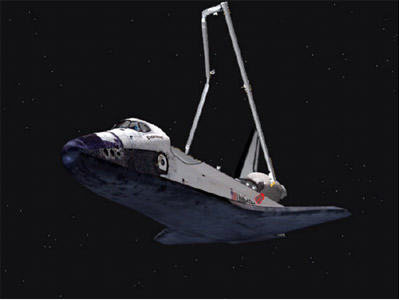Astronauts Scan Space Shuttle For Dings, Damage

Thisstory was updated March 12 at 3:15 a.m. EDT.
Astronautsaboard NASA?s shuttle Endeavour wrapped up their first full day in space byscanning for dings or damage to their spacecraft's heat shield.
Commandedby veteran spaceflyer Dominic Gorie, the astronauts used a lasersensor-tipped extension of the shuttle's robotic arm to scour the orbiter'ssurface for signs of damage from fuel tank debris that may have fallen freeduring launch.
Endeavour rocketedspaceward from NASA?s Kennedy Space Center in Cape Canaveral, Fla., Tuesday at 2:28:14 a.m. EDT (0628:14 GMT), and its STS-123 crew is on a marathon16-day mission to add a new Japanese room and a two-armed Canadianrobot to the International Space Station (ISS). The shuttle is due to dockat the orbiting laboratory late Wednesday.
Gorie,shuttle pilot Gregory H. Johnson and mission specialist Takao Doi of Japan finished the roughly six-hour inspection around 3:00 a.m. EDT (0700 GMT). Thedetailed inspection began at the shuttle's right wing leading edge, moved tothe nose cap and wrapped up with the left wing.
As the inspectiontool ?? a camera- and sensor-tipped 50-foot (15-meter) extension boom to theshuttle's robotic arm ? swept from the right wing to the nose cap, its cameras caughta pair of unidentified hands waving from windows on the Endeavour's flight deck.
"Wecan't recognize the hands," said spacecraft communicator Terry Virts from Johnson Space Center in Houston, Texas, eliciting a chuckle from astronauts on board thespacecraft.
Breaking space news, the latest updates on rocket launches, skywatching events and more!
Launchimages of Endeavour?s liftoff showed at least one instance of fuel tank foamloss about 83 seconds after launch, but mission managers said they did notthink anything struck the orbiter. Mission Control radioed Gorie and his crewthis morning to add that there were indications of a potential debris hit atEndeavour?s forward thruster system.
?We knowfolks are going to be looking at that hard,? Gorie replied. ?We're in great shape,thanks.?
NASA spaceshuttles are equipped with heat shield tiles and reinforced carbon-carbon (RCC)panels that protect the orbiter's wing edges and nose cap from the searingtemperatures of Earth's atmosphere during launch and landing.
"Webasically will be inspecting in great detail, every little, tiny little patchof thermal protection system on the shuttle," Johnson, a first-timespaceflyer, said in a NASA interview. "So it?s an all-day task."
The crewmust determine that the shuttle's defensive layer is intact before being giventhe OK to fly the spaceship back to Earth. NASA has kept a close watch onshuttle heat shield integrity since fuel tank debris damaged the shuttle Columbia?s left wing during its 2003 launch, leading to the loss of the orbiter and itscrew during landing.
"Weare in the process of scanning it and recording it and then downlinking it tothe ground, where they do all the hard work and tell us if we?ve got a goodvehicle to come home or not," said Gorie, now on his fourth spaceflight.
Experts onthe ground will analyze images from data gathered by the boom, formally knownas the orbital boom sensing system, once the astronauts finish downlinking theinformation to Earth.
"The endof OBSS is equipped with various sensor systems and cameras which can detectany damage as small as one-tenth of an inch," said Doi, a veteranastronaut with the Japan Aerospace Exploration Agency (JAXA). "it?s a verylong and delicate operation."
While theinspection was underway, the rest of Endeavour's seven-membercrew readied their ride for docking at the ISS, set for Wednesday night at11:20 p.m. EDT (0320 March 13). Endeavour mission specialists Robert Behnken,Mike Foreman, Rick Linnehan and Garrett Reisman checked the spacesuits slatedfor use in a Thursday night spacewalk, the first of five planned during theirISS construction flight.
NASA rousedthe astronauts from sleep at 4:28 p.m. EDT (0828 GMT) with the song "Linus& Lucy" from "A Charlie Brown Christmas," a tune pickedespecially for mission specialist Mike Foreman.
"Goodmorning, Houston, we appreciate that song," Foreman said. "We had anexciting trip to orbit yesterday morning and we're looking forward to our firstday in orbit."
- NEW VIDEO: Danger on the Pad: Shuttle Astronauts Practice Escape Drill
- VIDEO: ESA's New Science Laboratory
- VIDEO: Part 1: Europe's First ISS Cargo Ship, Part 2
SPACE.com staffwriter Dave Mosher contributed tothis story from Houston, Texas.

Clara Moskowitz is a science and space writer who joined the Space.com team in 2008 and served as Assistant Managing Editor from 2011 to 2013. Clara has a bachelor's degree in astronomy and physics from Wesleyan University, and a graduate certificate in science writing from the University of California, Santa Cruz. She covers everything from astronomy to human spaceflight and once aced a NASTAR suborbital spaceflight training program for space missions. Clara is currently Associate Editor of Scientific American. To see her latest project is, follow Clara on Twitter.
